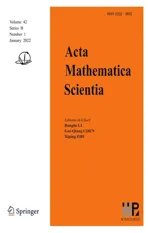FURTHER EXTENSIONS OF SOME TRUNCATED HECKE TYPE IDENTITIES*
2022-03-12HelenZHANG张文静
Helen W.J.ZHANG (张文静)
School of Mathematics,Hunan University,Changsha 410082,China E-mail:helenzhang@hnu.edu.cn
Abstract The main purpose of this paper is to generalize the study of the Hecke-Rogers type series,which are the extensions of truncated theorems obtained by Andrews,Merca,Wang and Yee.Our proofs rely heavily on the theory of Bailey pairs.
Key words theta functions;truncated series;Bailey pair;Bailey transform
1 Introduction
Here and throughout this paper,we adopt the following common notation:
where a and q are complex numbers with|q|<1.
Andrews and Merca in[3]proved the following truncated theorem on Euler’s identity:for m≥1,

Recall that a partition of a positive integer n is a finite nonincreasing sequence of positive integers λ1,λ2,···,λrsuch thatP=n.The function p (n) is the number of partitions of n.Andrews and Merca also proved that,for N,m≥1,

Guo and Zeng in[9]showed truncated theorems on the following well-known identities of Gauss[1]:
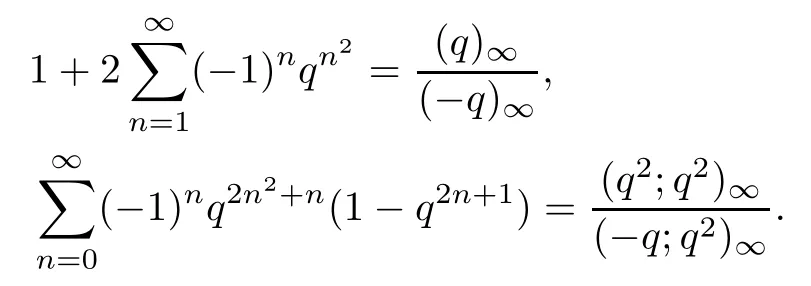
Recall that an overpartition of n is a partition of n in which the first occurrence of a number can be overlined.Letdenote the number of overpartitions of n and let pod (n) denote the number of partitions of n wherein odd parts are distinct.Guo and Zeng mentioned that for N,m≥1,

Quite recently,Wang and Yee[14]reproved the results of Guo and Zeng.To be more specific,for m≥0,
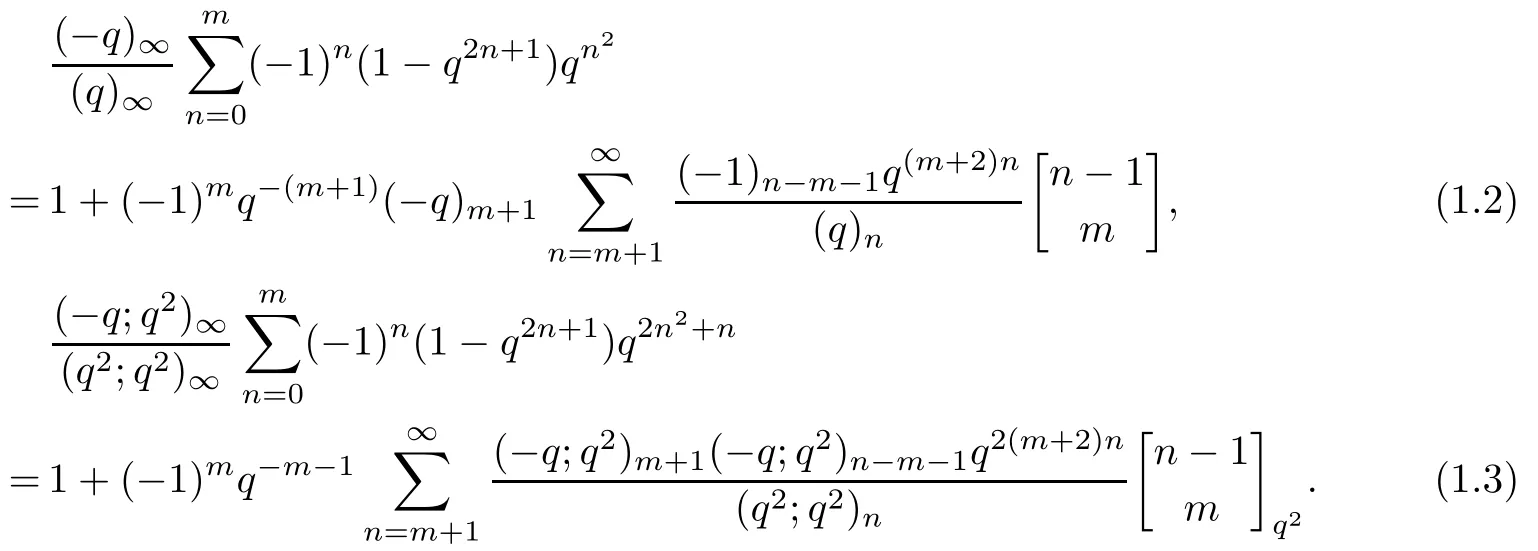
Moreover,Wang and Yee[14]also mentioned the following truncated Hecke-Rogers type double series:

Since then,there has been a great deal of work on truncated series,see,for example,[4,6,7,15].
In this paper,motivated by the works of Andrews and Merca[3],Guo and Zeng[9],and Wang and Yee[14],we study extensions of the truncated theorems (1.1)-(1.6).
Theorem 1.1We have

Theorem 1.2We have
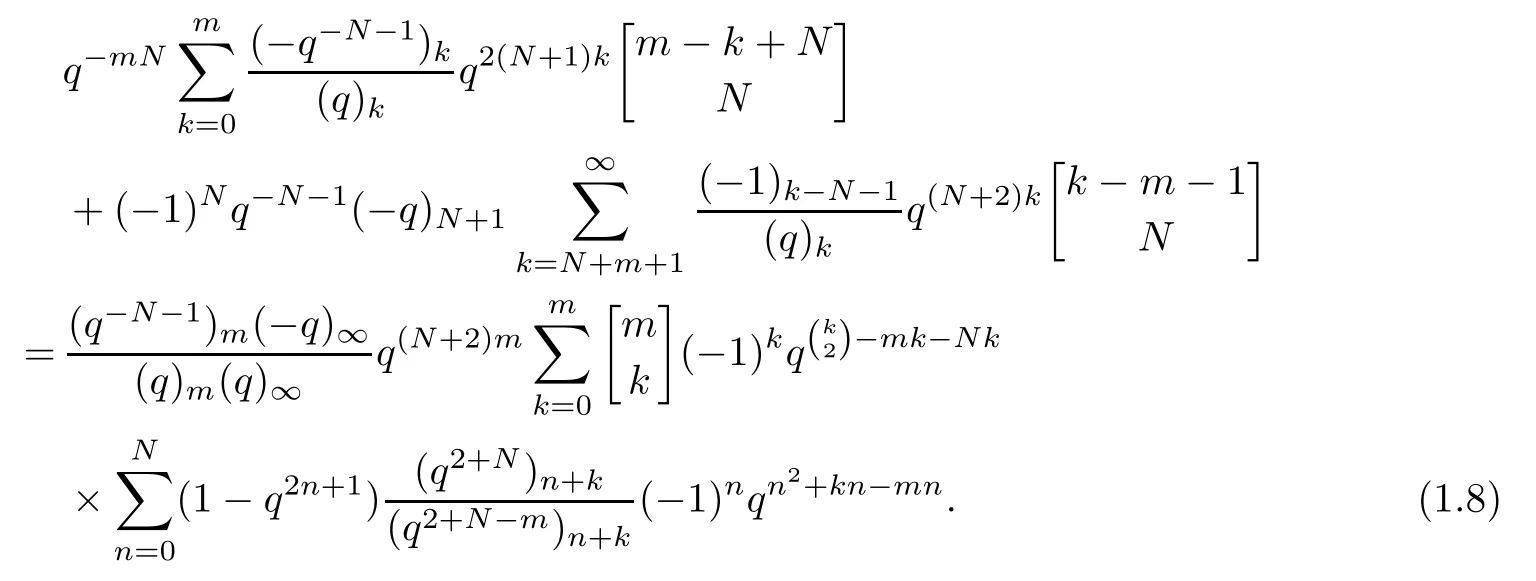
Theorem 1.3We have

Theorem 1.4We have

Theorem 1.5We have

Theorem 1.6We have

Remark 1.7Equations (1.1)-(1.6) can be obtained by setting m=0 in Theorems 1.1-1.6,respectively.
The approaches in the papers dealing with these themes are similar:they proceed by choosing different complex sequences in certain q-hypergeometric transformations.However,Wang and Yee directly utilized a transform due to Z.-G.Liu,while we show a new transform using Bailey pairs so that Liu’s transform is indeed generalized.
This paper is organized as follows:in Section 2,we state the general transformation formula for the q-series,which plays a key role in the proofs of the main theorems.We then establish several truncated Hecke-Rogers type series by choosing different Anin the transformation formula in Section 3.Moreover,extensions of the truncated theorems of Andrews-Merca and Guo-Zeng are discussed.Finally,in Section 4,we display several truncated Hecke-Rogers type double series.
2 Preliminaries
In this section,we use a Bailey pair to set up the general transformation formula for the q-series.We now recall the following lemma,which is due to[13]:
Lemma 2.1Let m be a nonnegative integer.Then,for|c/ab|<1,we have

where

Recall that (αn,βn) is said to be a Bailey pair relative to a if

Moreover,if only the βnis given,then αncan be determined using Bailey inversion (see[2]) as follows:

The pair (γn,δn) is said to be a conjugate Bailey pair with respect to a if the two sequences satisfy (see[5])

Then,under suitable convergence conditions,

where αnand δnare arbitrarily chosen sequences of n alone.For more details we refer to the reviews[16].
Theorem 2.2Let m be a nonnegative integer.If{An}is a complex sequence,then under suitable convergence conditions,we have

ProofIn (2.3),setting

we have
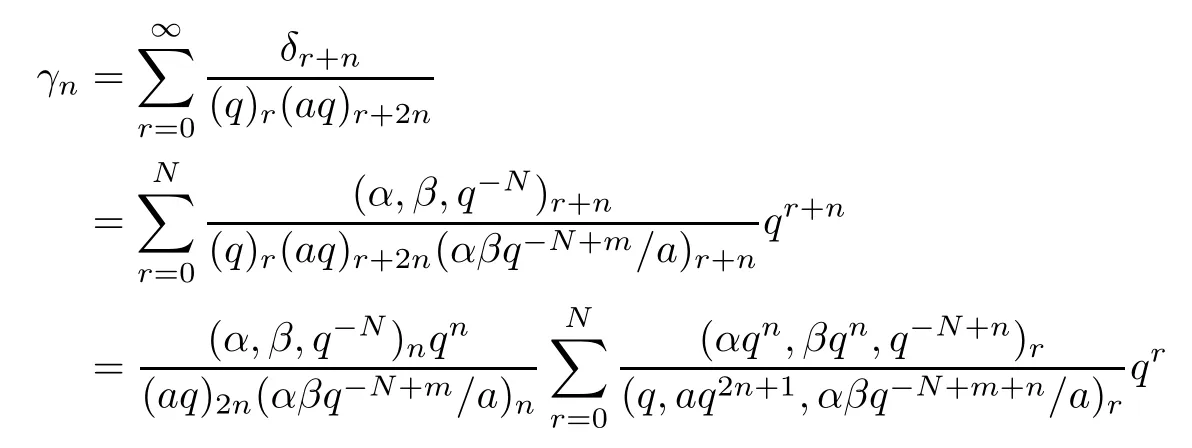

Replacing a,b and c by αqn,βqnand aq2n+1-min Lemma 2.1,respectively,we obtain

Substituting this into (2.4),we have

De fine α(a,n) to be
Hence,(α(a,n),q(m-1) nAn/(α,β)n) forms a Bailey pair.Inserting this Bailey pair into (2.6) yields

Replacing Ajby (α,β)jAj,we prove the theorem.
Remark 2.3When m=0,Theorem 2.2 becomes Theorem 9.2 in[12].
In the next lemma,a special case of Theorem 2.2 will be treated.
Lemma 2.4We have

ProofTaking α→q1+Na in Theorem 2.2,then letting a→q and β→∞,we have
Employing the identity

we infer that

Plugging (2.10) into (2.9),and replacing Anby q-mn+nAn,we complete the proof.
3 Truncated Hecke-Rogers Type Series
In this section,we prove Theorems 1.1,1.2 and 1.3.
Proposition 3.1We have

ProofReplacing Anbyin Lemma 2.4,we get

Employing the q-Vandermonde summation formula in[8],that is,

we infer that

The proof can be completed by substituting (3.4) into (3.1).
3.1 Proof of Theorem 1.1
Taking An=1/(q)nin Lemma 2.4,we have

Applying the following identity in[11,Lemma 4.1]:
3. Fountain: In some versions of the story, the fountain is a well. Traditionally, good spirits live in wells, and from thence came the tradition of throwing coins into wells in hopes of having a wish come true (Philip 1997).Return to place in story.

we infer that

Multiplying both sides of (3.6) by,we have

Denote the term on the left-hand side of the above equation by L1.Then we obtain that

where for the last equality,we apply the equation

Then,we have

Substituting z by qk-min the following identity from[8]:

we have

Then,L1can be rewritten as

Since


This completes the proof of Theorem 1.1.
The following corollary can be deduced by setting m=1 in Theorem 1.1:
Corollary 3.2We have

3.2 Proof of Theorem 1.2
Multiplying both sides of Proposition 3.1 by (-q)∞/(q)∞,we have

Denote the term on the left-hand side of the above equation by L2.Then we obtain that

By (3.10),L2is equal to

This completes the proof of Theorem 1.2.
Taking m=1 in Theorem 1.2,we obtain the following equation:
Corollary 3.3We have

3.3 Proof of Theorem 1.3
In Lemma 2.4,replacing q by q2,then taking

we obtain

By (3.3),
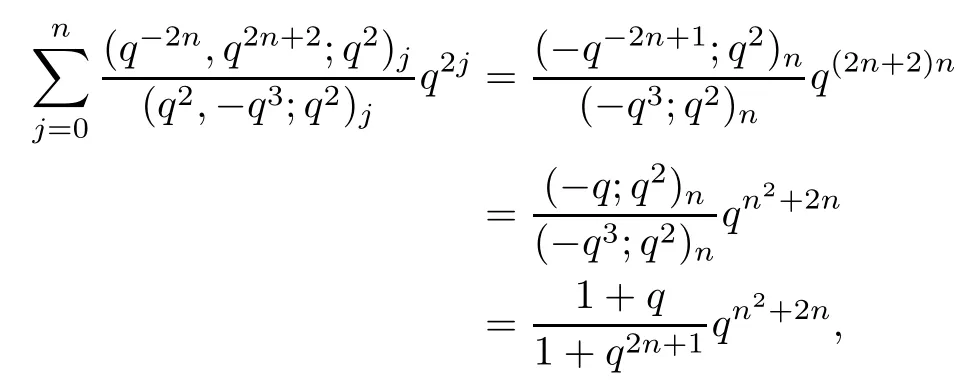
so we have

Multiplying both sides of (3.11) by (-q;q2)∞/(q2;q2)∞,we get

Denote the term on the left-hand side of above equation by L3.Then we obtain that
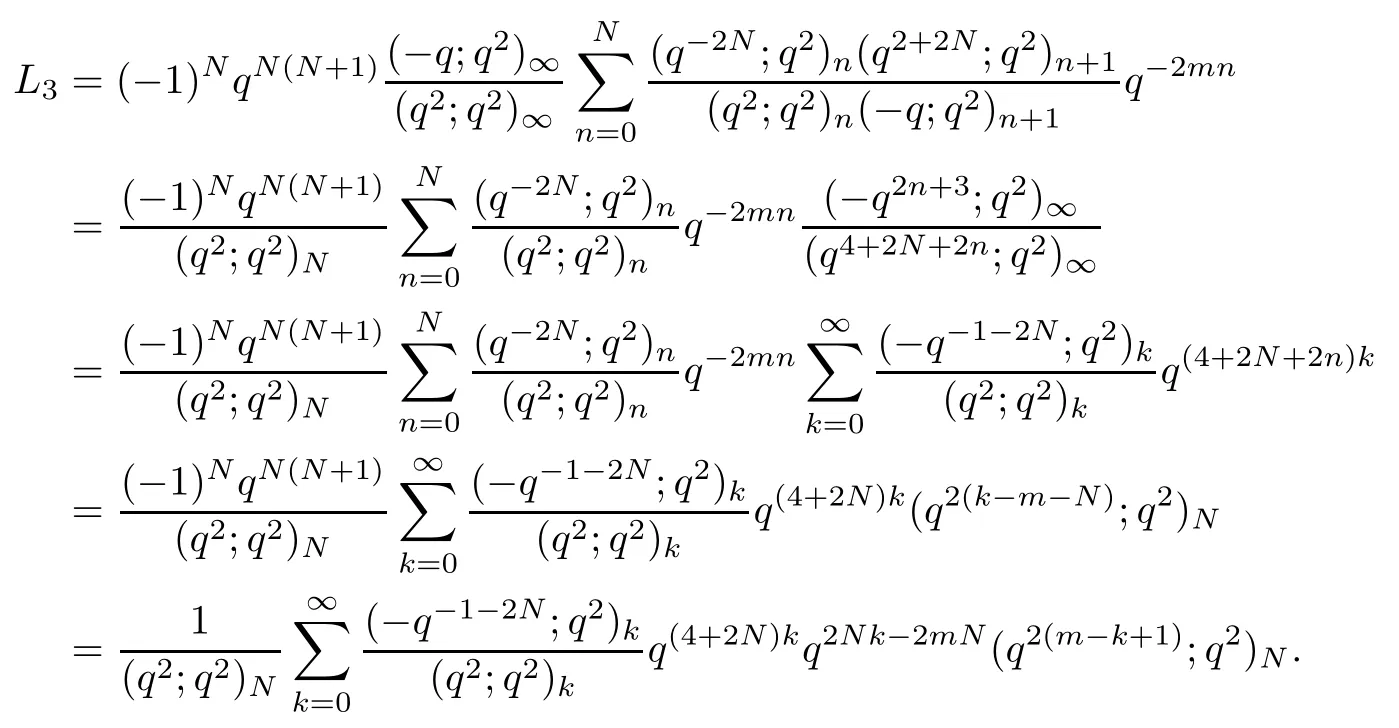
Splitting the summation of k into two sums,we have

This completes the proof of Theorem 1.3.
Taking m=1 in Theorem 1.3,we have the following corollary:
Corollary 3.4We have

4 Truncated Hecke-Rogers Type Double Series
In this section,we provide several truncated Hecke-Rogers type identities by taking different An’s in Lemma 2.4.
Proposition 4.1We have
ProofTaking An=1/(cq)nin Lemma 2.4,we get

Applying (3.5) with a=q in the above identity,we derive (4.1),which completes the proof.
4.1 Proof of Theorem 1.4
Setting c→0 in (4.1) and multiplying both sides by,we have

Using the following identity from[10,(7.10)]:

we arrive at

Denote the term on the left-hand side of (4.2) by L4.Then it can be rewritten as
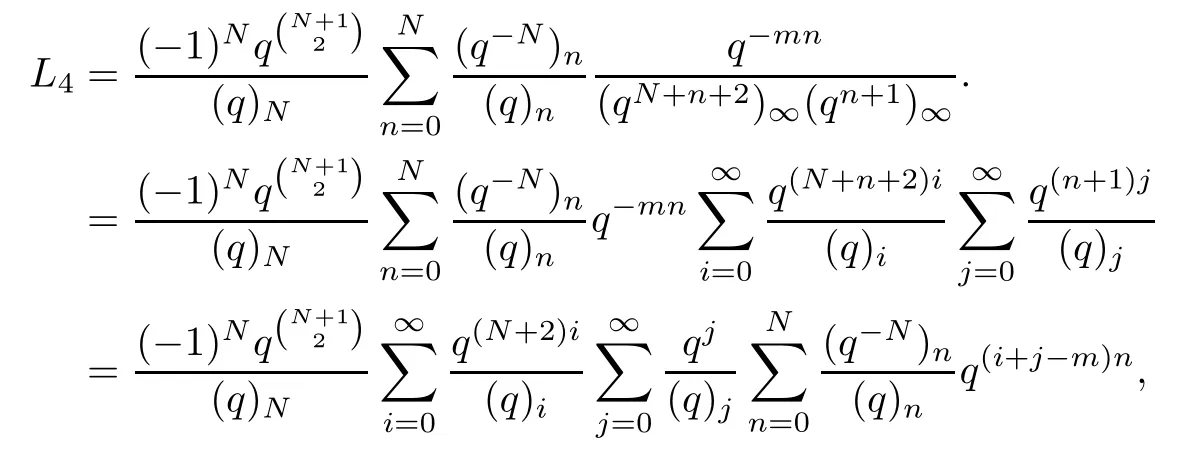
where the penultimate equality is due to (3.7).
Using (3.8),we have

Splitting the above summation of k into two sums yields
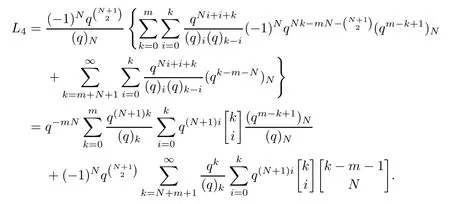
Substituting the above equation into (4.2),we finish the proof of Theorem 1.4.
The following is a special case of Theorem 1.4 by taking m=1:
Corollary 4.2We have

4.2 Proof of Theorem 1.5
Replacing c by-1 in (4.1),multiplying both sides by,and applying the following identity from[10,(7.5)]:

we deduce that

Denote the term on the left-hand side of (4.3) by L5.Then the calculations of L5are similar to those of L4in Theorem 1.4;that is,

Similarly,splitting the summation of k into two sums,we have


as desired.This completes the proof of Theorem 1.5.
The following is a direct consequence of Theorem 1.5,and it achieved by setting m=1:
Corollary 4.3We have

4.3 Proof of Theorem 1.6
Setting q→-q in the following equation from[10,(7.15)]:

we infer that

Replacing q and c by q2and-q in (4.1),respectively,and applying (4.4),we obtain

Multiplying both sides of (4.5) by (-q;q2)∞/,we obtain

Denote the term on the left-hand side of the above equation by L6.Then we have


Splitting the summation of k into two sums,we arrive at
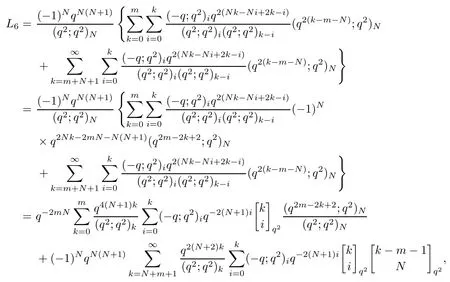
as desired.This completes the proof of Theorem 1.6.
Replacing m by 1 in Theorem 1.6,we obtain the following corollary:
Corollary 4.4We have

4.4 Truncated theorem on cubic partitions
We present another instance of truncated series identities which is related to the extension of the truncated series of (q)∞(q2;q2)∞.
Theorem 4.5We have


ProofTaking An=(-q)nin Lemma 2.4 and multiplying both sides by,we have

Denote the term on the left-hand side of the above equation by L7.Then we infer that

Splitting the summation of k into two sums as usual,we get that

This completes the proof.
Taking m=0,1 in Theorem 4.5,we obtain the following results:
Corollary 4.6We have

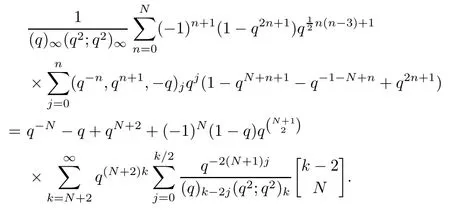
Remark 4.7The equation (4.8) is equivalent to Theorem 5.3 in[14].
We end this article with the following question arising from this project:
Question 4.8Can one give the combinatorial interpretations of Theorems 1.1-1.6?
猜你喜欢
杂志排行
Acta Mathematica Scientia(English Series)的其它文章
- OPERATOR NORM AND LOWER BOUND OF FOUR-DIMENSIONAL GENERALIZED HAUSDORFF MATRICES*
- UNBOUNDED COMPLEX SYMMETRIC TOEPLITZ OPERATORS*
- HYBRID REGULARIZED CONE-BEAM RECONSTRUCTION FOR AXIALLY SYMMETRIC OBJECT TOMOGRAPHY*
- A SPECTRAL METHOD FOR A WEAKLY SINGULAR VOLTERRA INTEGRO-DIFFERENTIAL EQUATION WITH PANTOGRAPH DELAY*
- TOEPLITZ OPERATORS FROM HARDY SPACES TO WEIGHTED BERGMAN SPACES IN THE UNIT BALL OF Cn*
- THE EXPONENTIAL PROPERTY OF SOLUTIONS BOUNDED FROM BELOW TO DEGENERATE EQUATIONS IN UNBOUNDED DOMAINS*
